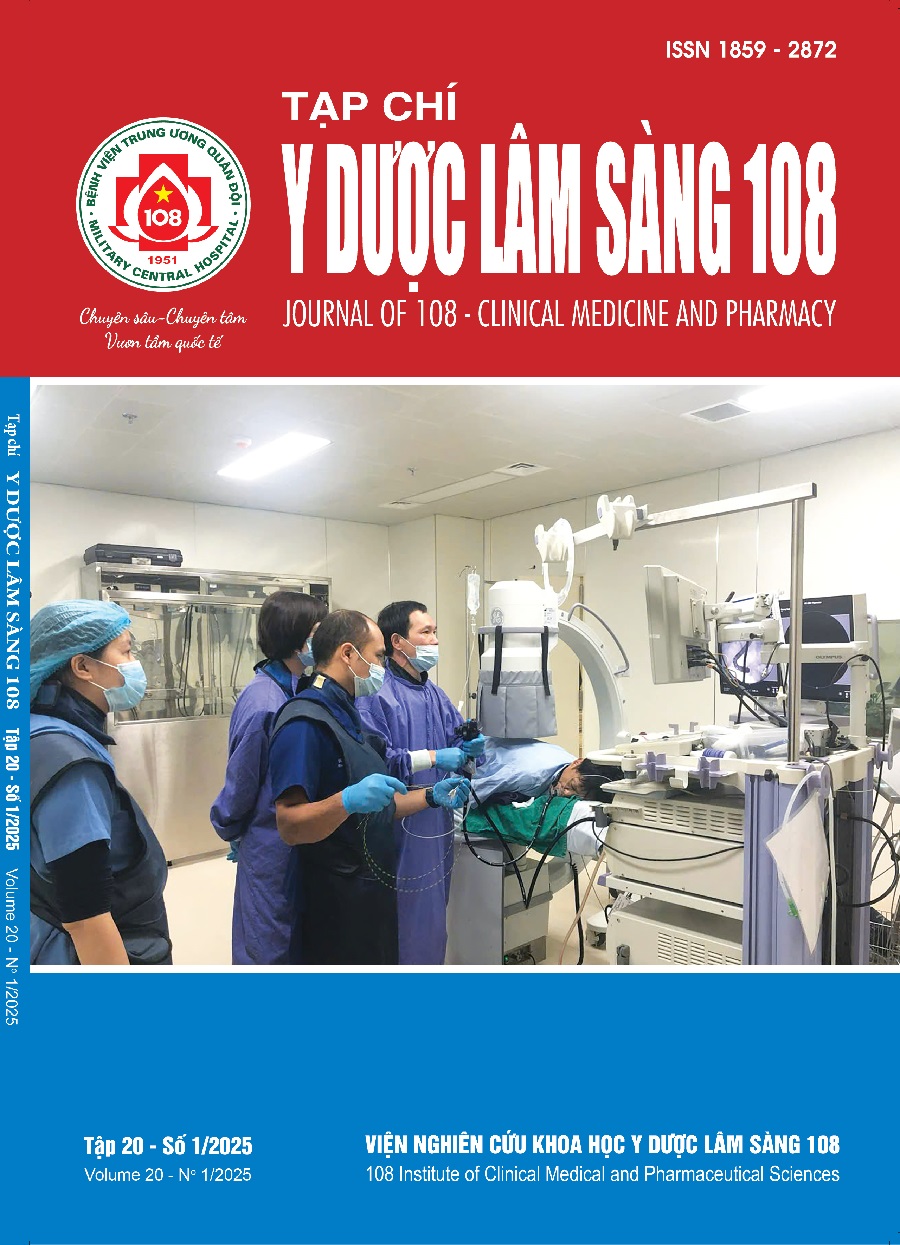Assessment of nutritional status and psoas muscle index (PMI) in pa-tients with liver cirrhosis
Main Article Content
Keywords
Abstract
Objective: Aims of our study is to investigate the nutritional status and psoas muscle index (PMI) in patients with cirrhosis as well as to find out their association with some clinical and paraclinical factors. Subject and method: A cross-sectional study was done on 2 groups of patients: One with liver cirrhosis (60 patients) and the other with non-cirrhotic patients (60 patients). All patients in the both groups had abdominal CT scan for different diagnostic purposes. PMI was canculated base on abdominal CT scan images taken at the third lumbar vertebra. Patients with cirrhosis were assessed nutritional status by SGA. The severity of cirrhosis was classified according to the Chid-Pugh score. Result: The non-cirrhotic group had an average PMI of both sexes of 5.06 ± 1.34cm²/m², for men and women, it was 5.44 ± 1.19cm²/m² and 3.55 ± 0.62cm²/m², respectively. The group of 60 patients with liver cirrhosis had an average PMI of 3.98 ± 1.12cm²/m², 4.24 ± 1.06cm²/m² for men, and 2.94 ± 0.66cm²/m² for women. The difference in PMI between the liver cirrhosis group and the control group was statistically significant with p<0.001. The PMI was also different in Child-Pugh (A and B) cirrhotic patients compared with Child-Pugh C and also in SGA nutritional status, with p<0.05, respectively. The nutritional status of patients with liver cirrhosis was classified as 35% SGA-A, 52% SGA-B and 13% SGA-C. The difference in nutritional status according to classification of liver cirrhosis was significant statistics with p<0.001. Conclusion: In our study, it was found that the decrease in muscle mass in the cirrhotic group is more than in the control group. PMI and nutritional status are also closely related to classification of liver cirrhosis according to Child-Pugh score.
Article Details
References
2. Anand BS (1999) Cirrhosis of liver. West J Med. 171(2): 110-115.
3. Juakiem W, Torres DM, Harrison SA (2014) Nutrition in cirrhosis and chronic liver disease. Clin Liver Dis 218(1): 179-190.
4. Dasarathy S, Merli M (2016) Sarcopenia from mechanism to diagnosis and treatment in liver disease. J Hepatol 65(6): 1232-1244.
5. Merli M, Giusto M, Lucidi C, Giannelli V, Pentassuglio I, Di Gregorio V, Lattanzi B, Riggio O (2023) Muscle depletion increases the risk of overt and minimal hepatic encephalopathy: Results of a prospective study. Metab Brain Dis 28(2):281-4. doi: 10.1007/s11011-012-9365-z.
6. Bojko M (2019) Causes of sarcopenia in liver cirrhosis. Clin Liver Dis (Hoboken) 14(5): 167-170.
7. Masuda T, Shirabe K, Ikegami T et al (2014) Sarcopenia is a prognostic factor in living donor liver transplantation. Liver Transpl 20(4): 401-407.
8. Nishikawa H, Shiraki M, Hiramatsu A, Moriya K, Hino K, Nishiguchi S (2016) Japan Society of Hepatology guidelines for sarcopenia in liver disease (1st edition): Recommendation from the working group for creation of sarcopenia assessment criteria. Hepatol Res 46(10): 951-963.
9. Shen W, Punyanitya M, Wang Z et al (2004) Total body skeletal muscle and adipose tissue volumes: Estimation from a single abdominal cross-sectional image. J Appl Physiol (1985) 97(6): 2333-2338.
10. da Silva Fink J, Daniel de Mello P, Daniel de Mello E (2015) Subjective global assessment of nutritional status - A systematic review of the literature. Clinical Nutrition 34(5): 785-792.
11. Marcell TJ (2003) Sarcopenia: Causes, consequences, and preventions. J Gerontol A Biol Sci Med Sci 58(10): 911-916.
12. Lucidi C, Lattanzi B, Di Gregorio V et al (2018) A low muscle mass increases mortality in compensated cirrhotic patients with sepsis. Liver International 38(5): 851-857.
13. Son SW, Song DS, Chang UI, Yang JM (2021) Definition of Sarcopenia in Chronic Liver Disease. Life 11(4):349.
14. Nguyễn Thị Mai Hương (2011) Nghiên cứu chỉ số MELD trong tiên lượng bệnh nhân xơ gan. Luận văn thạc sĩ Y học, Trường Đại học Y Hà Nội.
15. Hou L, Deng Y, Wu H et al (2020) Low psoas muscle index associates with long-term mortality in cirrhosis: construction of a nomogram. Ann Transl Med 8(6): 358-358.
16. Ohara M, Suda G, Kimura M et al (2020) Analysis of the optimal psoas muscle mass index cut-off values, as measured by computed tomography, for the diagnosis of loss of skeletal muscle mass in Japanese people. Hepatol Res 50(6): 715-725.
17. Kamal H, El-Leithy N (2021) The value of CT imaging and psoas muscle index in grading the severity of sarcopenia in liver cirrhosis patients and its impact on morbidity and mortality. The Medical Journal of Cairo University 89(9): 2157-2168.
18. Ebadi M, Wang CW, Lai JC et al (2018) Poor performance of psoas muscle index for identification of patients with higher waitlist mortality risk in cirrhosis: Poor efficacy of psoas muscle for mortality prediction in cirrhosis. Journal of Cachexia, Sarcopenia and Muscle 9(6): 1053-1062.
19. Moctezuma-Velazquez C, Ebadi M, Bhanji RA, Stirnimann G, Tandon P, Montano-Loza AJ (2019) Limited performance of subjective global assessment compared to computed tomography-determined sarcopenia in predicting adverse clinical outcomes in patients with cirrhosis. Clinical Nutrition 38(6): 2696-2703.
 ISSN: 1859 - 2872
ISSN: 1859 - 2872
